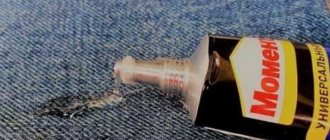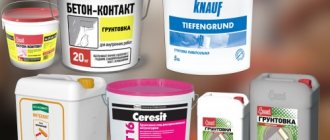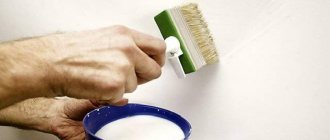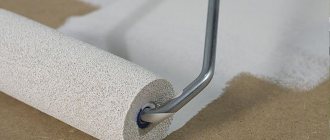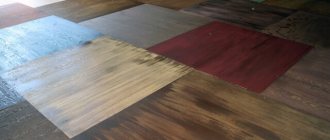Classic painting technology involves the existence of such a stage as priming the surface before painting. Of all the surfaces and materials, it is plastic that creates the most difficulties. Primer for plastic is not compatible with all substrates. Therefore, before purchasing, it is so important to study the instructions created by the manufacturer.
One of the most convenient and widespread options today is liquid enamel primer with an acrylic base, which dries almost instantly. The painting itself will cease to be durable if a layer of primer is not first applied. After some time, the paint simply begins to crack. The soil itself begins to peel off. The product loses its attractive appearance.
Why is a regular primer not suitable for plastic?
Plastic surfaces require priming more than others.
Plastic has features that distinguish it from other materials. The material is not perfect. In some parameters, plastic is superior to other materials, in others it is inferior to them. The high density of plastic elements made their adhesive properties worse. This affected the adhesion of paints and varnishes to the surface.
Painting on an unprimed surface will cause the paint to roll off and cause smudges. It is necessary to prime the plastic, otherwise painting will become impossible. The primer also allows you to repair minor inaccuracies or damage, which simplifies repair work.
How to dye at home
Many users start painting plastic at home, since applying the coating themselves is much cheaper than turning to specialists for such a service.
When processing plastic surfaces, the same painting technology must be followed:
- First, the product is cleaned of contaminants. If the item is simply dirty or dusty, it can be washed with regular soap and water. You can remove traces of mold or fungal stains using bleach. After this treatment, the surface of the product is thoroughly dried. If the surface you plan to paint has flaws, minor defects, or unevenness, they can be eliminated. Putty will help you with this.
- The next stage is degreasing the plane. For these purposes, a special solvent is suitable, which can remove greasy marks and remnants of the old coating. Next, the working surface is washed and dried again.
- Afterwards, the plane is ground to ensure better adhesion of the applied layer to the base. Sanding paper with a fine-grained surface (up to 180 microns) is suitable for this. Having completed sanding the product, it must be cleaned again and re-treated with a solvent.
- And, directly, the process of painting PVC plastic. If you are using aerosol paint, you should shake the can each time before applying it to the surface. During surface treatment, the can should be held vertically, applying each subsequent layer only after the previous one is completely dry. Painting is performed in circular movements of large amplitude in the direction from left to right. If you prefer to use enamel to finish polyvinyl chloride, try to apply it in thin layers. First, you can make several wide stripes without lifting the brush from the plane, and then blend the composition with gentle movements to get the coverage as smooth and even as possible.
Once the item is completely covered with the paint mixture, it can be left to dry completely. A product painted from an aerosol can dries in about 25-35 minutes. A layer of enamel applied with a brush yourself will take much longer to dry (from 8 to 72 hours). To secure the result, varnish is usually used.
Surfaces treated with paints and varnishes can be coated with varnish either in aerosol form or regular (liquid). In this case, the only difference is the time during which the coating dries. If, after spraying, the varnish layer dries in about 25-30 minutes, then a surface coated with regular varnish will be ready for use only after 2-2.5 hours.
The varnish applied over the paint creates an additional protective layer on the surface. A product treated in this way will last much longer without loss of color and other performance qualities.
Types of primers
Primer for plastic must have a designation on the packaging that is suitable for this material.
At the same time, the compositions differ in properties and composition, so you should study all the nuances before deciding on the most suitable product.
Protective primer for plastic
Compositions containing zinc, aluminum, lead and other metal powders provide reliable protection for plastic structures. The binder in this case is epoxy resins. This plastic primer is often used to coat automotive parts for painting. Even if the soil layer is damaged, the presence of zinc oxides ensures the formation of a film that prevents oxidation of the metal base of plastic elements.
Primer “Liquid plastic”
This type of primer is suitable not only for plastic surfaces. It is used for priming metal, concrete or wooden bases. Thanks to the use of food-grade polyethylene in production, it was possible to create a safe primer. The absence of harmful effects on humans allowed the use of such soil in hospitals and schools. This primer can withstand low and high temperatures, is moisture resistant and durable. It is easy to use.
Adhesive primer for plastic
Adhesive primers are single-component. They are applied before painting the plastic. Can be combined with alkyd and base paints and varnishes. In order for the product to provide maximum adhesion to the paint, you should carefully prepare the surface: clean, degrease, and treat with an abrasive cloth.
Alkyd primer for plastic
Compositions based on modified resins can not only improve the adhesion of the base to the coating, but also hide minor damage. This was achieved through a combination of alkyds with fillers, inhibitors, solvents and pigments. The product is excellent for external use.
Acrylic primer for plastic
Resistant to temperature fluctuations, effective and acrylic primer on plastic. When applied, it forms a transparent protective layer on the plastic surface, which improves adhesion and helps mask minor defects. The line of acrylic primers includes options with a spray gun. The aerosol can contains a composition completely ready for use. It is easy to apply. Despite the fact that aerosol packaging increases the cost of soil, the savings lie in its rational distribution.
About foam processing
The use of a primer is mandatory when external work is carried out on the facade. But the material itself is not applied directly to the foam, but to the surface that will be finished with insulation.
Deep penetration acrylic primer is used for walls that will be finished with foam plastic in the future. Thanks to this, the structure has an increased shelf life and receives additional protection from destruction ahead of time. 1 layer is enough if brick is primed under the foam. If the surface is porous, then at least double processing will be required.
Primer is required for any foam products located outside or inside the house. The main thing is to apply the composition directly to the plaster. The putty should be applied to the base in a very thin layer. After this, you need to wait until the decorative element is completely dry.
How to properly prime plastic (2 videos)
Types of primer for plastic (18 photos)
Which primer to choose
When choosing a primer for plastic, be sure to consider the following nuances:
- the need to increase adhesive properties, product protection, or a combination of both properties;
- operating conditions of plastic products: humidity, temperature, exposure to precipitation;
- type of finishing coat and compatibility of paint and primer.
A high-quality primer for plastic is not cheap. Popular brands offering effective priming products set a price of at least 1000 rubles per 1 liter.
Acrylic based primer
Primer enamel has a remarkable ability to create adhesion to the surface of plastic products. Additionally, before applying it, it is not necessary to treat the plastic with any other priming agents. The resulting film is characterized by increased strength and resistance to mechanical and chemical influences. This enamel is suitable for outdoor work involving painting plastic parts exposed to direct sunlight and precipitation. In addition, the enamel primer on acrylic has the ability to withstand low temperatures without cracking or crumbling.
Using aerosol primer-enamel, you can quickly renew the surfaces of plastic parts and give them a well-groomed appearance. This enamel primer is economical in consumption and, despite its liquid consistency, when applied to vertical surfaces, it adheres perfectly to them, without leaving streaks.
Enamel primer is sold ready for use. The industry offers a wide variety of colors for this material, so choosing the right color is not difficult.
The enamel goes on sale in the form of aerosol cans, which allows it to be applied easily and evenly to products with any surface shape.
How to apply primer
The technology for applying the priming composition is important, since the final result depends on compliance with the priming rules. To ensure that the primer lays down perfectly and ensures maximum adhesion, work is carried out in the following sequence:
- Washing and cleaning the plastic surface from dirt and dust.
- Clean the plastic with sandpaper.
- Degrease the base.
- Use an antistatic agent to prevent dust from sticking.
- Cover the surface with the first layer of primer. Spray with aerosol or apply primer with a brush.
- Wait for the first layer to dry (10-15 minutes). Apply another 2-3 layers of coating.
Since the primer for plastic dries, the part is ready for painting within 15 minutes after coating with the last layer.
It is also better to apply the paint composition in several layers so that it is uniform and homogeneous.
How to treat the primer so that the enamel adheres well?
Kudo and other brands of primers are applied only to matte surfaces. You should use fine sandpaper if the base is initially glossy.
The surface becomes matte at the same time as water is applied to it. After this, preparations are made to apply primer for plastic. A spray bottle and compressor help apply materials that are sold in cans.
- After the first application, be sure to wait until everything is completely dry.
- Then they move on to leveling. This is done in the same way as in the case of matting.
- The next stage is complete drying. A wet surface with primer is not allowed.
- Before further work, it is recommended to wipe the product with rags or napkins that have been previously soaked in solvent.
- Only after completing absolutely all procedures can you begin the coloring itself.
Each professional painter has his own techniques to help prepare the primer for the application of other materials. Acrylic base is no exception.
How to clean primer from plastic
When priming, sometimes it becomes necessary to wash off the remaining primer composition from the plastic. This must be done quickly and correctly, since if done incorrectly there is a risk of damaging the surface or leaving stains from the primer. The most accessible method of cleaning soil from plastic is vinegar essence. Since it has specific properties and odor, precautions should be taken: wear special protective clothing and ensure the room is ventilated.
Important! When cleaning plastic countertops and window sills, do not use acids, as the primer will melt and leave stains.
Also used to remove primer from a plastic surface:
- cleaner for polyurethane foam;
- window cleaner "Mr. Muscle";
- baking soda;
- fine-grained sandpaper.
You can also cover the contaminated area with a wet cloth. The soil will swell and can be washed away.
Priming in the case of plastic surfaces is a mandatory step. Without applying a primer, the paint coating will not adhere to the surface. Using the right primer will help create additional protection for plastic elements and ensure high-quality adhesion of the paint to the surface.
General information
The difference between plastic and other materials
The main differences between plastic compared to other materials, for example, concrete or metal, include the following indicators:
- Low level of adhesion (that is, adhesion) with varnishes and paints.
- Light weight.
- Excellent plasticity of the material.
- Anti-corrosion.
- Excellent thermal insulation qualities.
- High degree of resistance to precipitation.
- Excellent noise suppression performance.
- Resistance to aggressive environments.
Plastic products undergo an aging process over time, and for this reason, applying paint and varnish coatings will have a positive effect on increasing their service life.
Choosing a primer for plastic
When choosing a primer for coating plastic products, you should pay attention to the compatibility of the primer and coloring compositions. They should not be the same in composition, nor in scope of application. One should also take into account the properties of plastic, or rather, the fact that the material can change under the influence of deformation. For example, when a plastic window sill breaks, cracks and creases appear on its painted surface. It is important to know that the primer composition and the paint coating must be equally susceptible to possible deformations.
Technology of painting foamed polyethylene in stages
Next, we’ll tell you how to paint large or small thermal insulation products made of polyethylene with your own hands. Before tinting begins, the polymer surface must be carefully prepared for the process.
- First of all, study prices in online stores. Then find a product that is inexpensive.
- Then prepare the insulation, primer and paint and the necessary tools for the job.
- We clean the surfaces for thermal insulation of pipes with a special abrasive tool. This will help smooth out minor irregularities and roughness.
- Now we proceed to degreasing the outer surface using a solvent or white spirit.
- We treat the treatment area with an antistatic agent. This will push dust particles away from the surface.
- Apply primer in 1-2 layers.
- After the primer has dried, paint for polyethylene is applied. After about 40 minutes the product will dry.
This method of painting polyvinyl chloride (PVC) products is suitable for any type of thermal insulation.
Types of paints for plastics
Recycled polymers can be colored using a variety of means. But which paint for polyethylene is more effective than others - acrylic, stamp, water-based, aerosol?
- Water-based alkyd paint or enamel. A product with the addition of a hardener, which makes the coloring composition durable. The colorless, odorless polymer makes the painted finish smooth, uniform and fade resistant. This is a durable compound. When applying alkyd paint, the surface does not need to be prepared in advance.
- Stamp paint. This product dries quickly and lasts a long time on any surface. After drying, it does not crack or wear off.
- Aerosol paint for PVC. To process polypropylene foam with aerosols, you do not need a brush and roller. Paint for polyethylene is easy to apply, dries evenly, and lasts a long time on the surface of the thermal insulation. We spray the surface of the plastic from afar with an aerosol and let it dry for about an hour.
It is better not to use acrylic dyes, because acrylic curls from high temperatures and quickly peels off the painted area.
Not all coloring compounds are easy to apply to PPE and can remain on it for up to ten years. Polyethylene paints of different shades can be found on our website.
The catalog in the online store cilindri.ru presents a wide variety of thermal insulation materials and means for painting them. Here you can buy the best products at low prices. Our paint for polyethylene is inexpensive and of high quality. The website has a wide range of products. Delivery is carried out promptly and efficiently.
← All articles
Application area
Liquid plastic is used for coloring:
This enamel primer can be used for painting children's playgrounds, plastic street benches, fences, and information boards.
Apply as needed in one or two layers. It has such properties as durability, high strength, resistance to precipitation, lays down in an even layer, does not crack or peel when exposed to negative temperatures.
The main rule that must be observed when using enamel primers to coat plastic surfaces: they must match the type of plastic they are applied to. And if painting is carried out after the primer, it is necessary that the paint and primer are compatible with each other.
Results:
We prime the plastic bumper ourselves
As it becomes clear, priming surfaces is a mandatory step when preparing walls for painting or other finishing work. Having a lot of positive qualities, soil can not only improve adhesion properties, but also prevent the appearance of mold. When purchasing in a store, always pay attention to whether they contain antiseptics or not.
Choosing a primer for plastic
Having been involved in fiberglass since I was 16 years old, I definitely know what kind of soil is best to choose for DIY work. However, many people don't understand the importance of choosing the right ingredients, and that's why I want to share my knowledge. The fact is that the correct choice of primer is important not only because of the weak adhesion properties of plastic and paint, but also because of the elasticity of the material itself. As everyone knows, plastic can “play” and only special primers and paints are suitable for it, which we’ll talk about.
Primer for plastic

